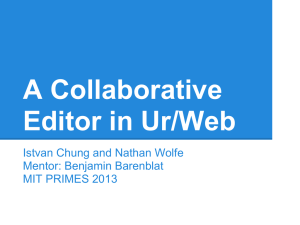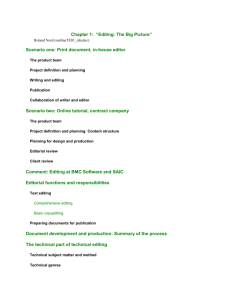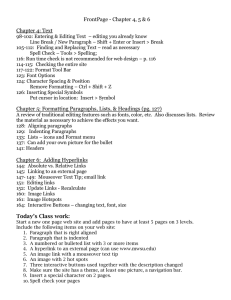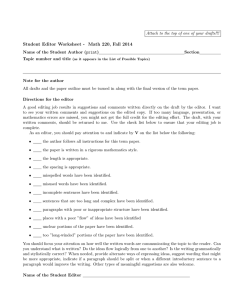TEAMS Writing and Editing Services Important Information about Editing Services
advertisement
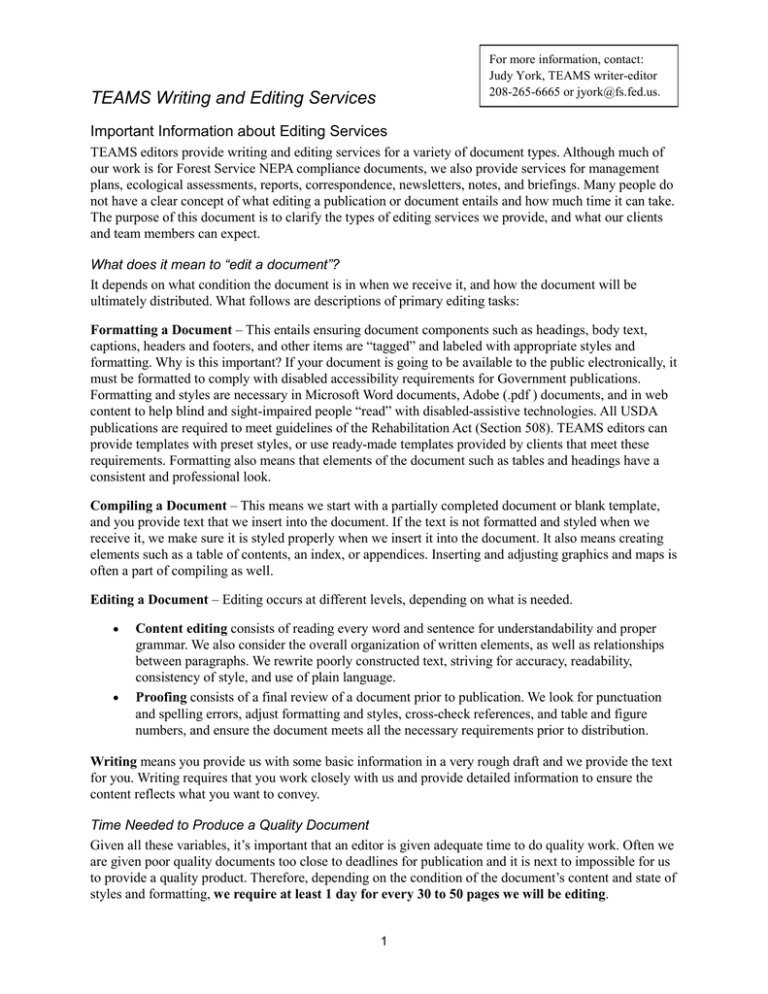
For more information, contact: Judy York, TEAMS writer-editor 208-265-6665 or jyork@fs.fed.us. TEAMS Writing and Editing Services Important Information about Editing Services TEAMS editors provide writing and editing services for a variety of document types. Although much of our work is for Forest Service NEPA compliance documents, we also provide services for management plans, ecological assessments, reports, correspondence, newsletters, notes, and briefings. Many people do not have a clear concept of what editing a publication or document entails and how much time it can take. The purpose of this document is to clarify the types of editing services we provide, and what our clients and team members can expect. What does it mean to “edit a document”? It depends on what condition the document is in when we receive it, and how the document will be ultimately distributed. What follows are descriptions of primary editing tasks: Formatting a Document – This entails ensuring document components such as headings, body text, captions, headers and footers, and other items are “tagged” and labeled with appropriate styles and formatting. Why is this important? If your document is going to be available to the public electronically, it must be formatted to comply with disabled accessibility requirements for Government publications. Formatting and styles are necessary in Microsoft Word documents, Adobe (.pdf ) documents, and in web content to help blind and sight-impaired people “read” with disabled-assistive technologies. All USDA publications are required to meet guidelines of the Rehabilitation Act (Section 508). TEAMS editors can provide templates with preset styles, or use ready-made templates provided by clients that meet these requirements. Formatting also means that elements of the document such as tables and headings have a consistent and professional look. Compiling a Document – This means we start with a partially completed document or blank template, and you provide text that we insert into the document. If the text is not formatted and styled when we receive it, we make sure it is styled properly when we insert it into the document. It also means creating elements such as a table of contents, an index, or appendices. Inserting and adjusting graphics and maps is often a part of compiling as well. Editing a Document – Editing occurs at different levels, depending on what is needed. • • Content editing consists of reading every word and sentence for understandability and proper grammar. We also consider the overall organization of written elements, as well as relationships between paragraphs. We rewrite poorly constructed text, striving for accuracy, readability, consistency of style, and use of plain language. Proofing consists of a final review of a document prior to publication. We look for punctuation and spelling errors, adjust formatting and styles, cross-check references, and table and figure numbers, and ensure the document meets all the necessary requirements prior to distribution. Writing means you provide us with some basic information in a very rough draft and we provide the text for you. Writing requires that you work closely with us and provide detailed information to ensure the content reflects what you want to convey. Time Needed to Produce a Quality Document Given all these variables, it’s important that an editor is given adequate time to do quality work. Often we are given poor quality documents too close to deadlines for publication and it is next to impossible for us to provide a quality product. Therefore, depending on the condition of the document’s content and state of styles and formatting, we require at least 1 day for every 30 to 50 pages we will be editing. 1 Time Estimates for Various Document Types The table below shows a variety of editing tasks and estimates for time needed. Times for NEPA documents assume someone else is drafting the documents and are dependent upon how much actual writing or compiling the editor must do. Task Edit a non-NEPA document (annual report, plan) Create specialist report or EA/EIS template Max hours (in-depth editing) Min Hours (Basic editing) 16 to 24 hours 2-3 days 8 hours 1 day 1 hour 16 to 24 hours (2 to 3 days) 4 to 8 hours (0.5 to 1 day) Review content, format and edit: 8 to 16 hours (1 to 2 days) per report Edit/format only: 4 to 8 hrs per report Chapters 1 and 2 24 to 40 hours (3 to 5 days) 16 hours (2 days) Chapter 3 80 to 120 hours (10 to 15 days) Edit/format only: 24-40 hours (3-5 days) Appendices 16 to 32 hours 2-4 days 8 to 16 hours 1-2 days Response to comments Compile and edit: 40 hours (5 days) Edit/Format only: 16 hrs (2 days) Scoping documents Edit Specialist Reports Create an Index Decision document Convert Documents to pdf format Editor from scoping to decision 1 to 2 days 24 to 40 hours (3-5 days) Edit/format only: 8-16 hours 5-30 min per document 20-30 days EA 40-60 days EIS 2 comments Based on 50-page report These are already prepared, extra time may be needed if client wants something special or different Formatting and review of scoping notice, legal ads cover letter or NOI. Max time based on reports 20 pages or less. Includes review of content for readability and organization (NEPA review may be included, depending on editor’s skills). Reports over 50 pages may take 1-2 days more. Max hours assumes all components needed are finalized and available Time depends on how long document is and whether content review is needed. Max. hours include compiling Chap 3 from specialist reports. If IDT leader compiles, max hours can be cut in half. Depends on volume, complexity, and whether info is from a previously published source. Max time assumes specialists are answering questions and editor is compiling into response document or appendix. Depends on complexity Max hours may be influenced by type of decision and whether editor writes any of it. Larger file sizes take longer to convert. If document does not meet accessibility requirements, more time may be needed Estimate based on assistance with scoping documents, 6-8 specialist reports, EA/EIS, and decision documents. Basic and Advanced Editing Services Basic editing services are less intensive than advanced editing services. The following are examples of what these terms mean. Basic editing includes: • • • • • providing templates for styles correcting typos and errors minimal rewriting and correcting poorly written sentences checking table and figure numbers, updating links and cross references • • • • adjusting tables and making all table styles consistent cleaning up left over track changes and comments creating table of contents creating web text for graphics converting documents to pdfs Advanced editing includes all of the above plus one or more of the following: • • • • complete formatting of styles, headers/footers, and overall document layout some writing or compiling sections of a document rewriting for better readability and consistency • • • inserting hyperlinks, constructing tables and figures pointing out document inadequacies or inconsistencies adjusting and manipulating graphics to reduce file size creating an index Other Editor Services Based on Availability Microsoft Word Training We can provide various levels of training to help you or your employees work more efficiently with Word and its document building functions. Training can be done using a web-based meeting format in 1-hour or half-day sessions. Topics include: • • • • • Word Function Basics – this training assumes a person has already been using Word but has never taken a class. It’s a cut above an introductory course, focusing on settings and functions most people are unaware of. Styles and Templates – this training teaches users about how to use styles and templates to not only create professional looking documents, but to allow for merging content into one document with ease. This training also emphasizes the connection between styles and compliance with section 508 of the Rehabilitation Act (disabled accessibility requirements). Tables – this training teaches how to create and manipulate tables, and how to insert automated table captions. Section Breaks, Headers and Footers – this training focuses on using section breaks to influence the layout and sequence of pages in your document. It shows you how section breaks influence headers and footers, page numbers and page layout and orientation. Graphics – this training focuses on how to add graphics to your document in a way that keeps them looking good but keeps overall document file size lower. Grant Writing Editor Janice Schultz has extensive experience with grant writing and has even helped her local fire station acquire much needed funding. 3

